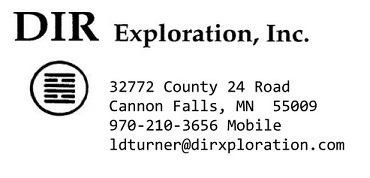DIR Exploration, Inc.
DIR is pioneering a new hard data- and statistically-based approach to hydrothermal mineral deposit targeting. The approach uses training sets of surface geochemical data obtained from locales containing known ore deposits, as well as general geochemical hydrothermal deposit genesis theory, to statistically estimate linear equations predictive of ore deposit quality, amount, and location in both greenfields and brownfields exploration terrains.
Public domain reports regarding the DIR mineral exploration innovation can be found here. See especially the review paper entitled, "Mineral deposit tasting and smelling: linear regression definition of practical geochemical targeting models for hydrothermal mineral systems".
The primary advantages to this new, direct approach to the mineral exploration task of locating unrecognized economic ore bodies are:
- From the outset, mineral exploration field work is objectively focused on projects with the highest probability of eventually proving to be economic deposits;
- The method minimizes the multitudinous negative effects of the major observational bias common to the mineral exploration industry; i.e., "the streetlight effect" (https://en.wikipedia.org/wiki/Streetlight_effect); and,
- The effectiveness of the geochemically-based technique is relatively unaffected by mineral deposit depth of burial within host rock.
DIR possesses a growing inventory of geochemical linear equations/targeting models for specific types of the hydrothermal deposts of North America, including:
- The "Hishikari-style" low-sulfidation high grade gold-silver vein deposits of Nevada, Arizona, and Washington State (based on surface bulk rock chip sampling);
- The Mississippi Valley-type lead-zinc deposits of Missouri (based on stream sediment samples);
- Cripple Creek-type Au-Ag-Te deposits (based on stream sediment samples);
- Carlin-type sediment-hosted gold deposits (based on stream sediment samples);
- North American orogenic gold deposits (based on lake sediment samples); and
- The uranium-mineralized collapse breccia pipes of northern Arizona (based on surface bulk rock chip samples). With regard to this deposit type and its linear equation geochemical model, note that DIR has already completed a resource assessment of 85% or more of all surface-identificable collapse structures existing on public lands administered by the US Forest Service and Bureau of Land Management in northern Arizona.
DIR is currently conducting field follow-up examinations of orogenic gold deposit anomalies it has identified in Minnesota.
With the exception of the orogenic gold deposit targeting model being employed by DIR itself in Minnesota, DIR is willing to grant exclusive licenses to use of the mineral deposit targeting models and DIR work described above. DIR is also willing to generate custom hydrothermal deposit type exploration models for outside parties, also on an exclusive licensing basis. Persons interested in such licensing arrangements can contact Larry Turner, DIR's president and managing geologist, using the information provided below.
CONTACT

